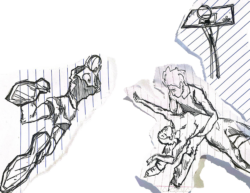Decimated by the loss of stalwarts to conferences with FBS football and more lucrative media deals, the Big East enters a new era that will take time to adjust to. The protracted schism left some bitterness.
“Does it do anyone any good to sit and lament over [the process]? We had this discussion all last year, we’re going to have it again now,” said Head Coach John Thompson III. “Is it different? Absolutely. But I’m more excited about the future than I am worried about the past.”
For players like senior forward Nate Lubick, adjusting to this new landscape will be difficult.
“Growing up as a kid I was a Big East kid and rooting for Big East,” said Lubick. “So I thought I would be playing against Syracuse and Louisville for 4 years. So I wouldn’t use the word disappointing [to describe the realignment process]. It’s a change.”
Despite having one of the best basketball leagues in the country for over 30 years, the Big East conference’s football league lacked the financial prowess necessary to thrive in the current state of college athletics. Realizing that other conferences could provide more financial benefits, the Big East’s football schools began to seek out new homes for their respective athletic programs.
And then the dominoes began to fall. Syracuse, Pittsburgh, Louisville, and Notre Dame all departed for the ACC, West Virginia bolted for the Big 12, and Rutgers joined the Big Ten. Out of fear of losing all the money associated with having a football league, the Big East frantically invited schools such as Memphis, SMU, Houston, and UCF in an attempt to compensate for the mass exodus.
Feeling these new invitees did not align in terms of geography, as well as basketball and academic tradition, non-football members DePaul, Georgetown, Marquette, Providence, Seton Hall, St. John’s, and Villanova voted to dissolve the league and return it to its basketball-centric roots in December of 2012. And after intense negotiations with the remaining football schools such as Connecticut and Cincinnati, the seven schools were able to retain the Big East name as well as the right to have its annual conference tournament at Madison Square Garden.
In an attempt to bolster the league’s ranks, the Big East invited non-football playing, basketball-centric schools Butler, Creighton, and Xavier to form a revitalized 10-team league last March. These new members will bring great tradition and competitiveness to the new league. Butler, with its famed venue Hinkle Fieldhouse, has appeared in the national championship game twice in the last five years. Creighton, with five tournament appearances in the last decade, boasts one of the country’s most rabid fanbases, and Xavier has been to the NCAA Tournament in 11 of the last 13 seasons.
“We added three great teams in Xavier, Creighton, and Butler,” said Lubick. “We are really excited about all them and we are excited about making different road trips and going to get in the Midwest a bit.”
Thompson thinks these teams will make the new league one of the most competitive in the country.
“I think that over time, even though it’s easier to talk about who’s not in the Big East or who left, over time those same feelings and emotions towards… the new teams, is going to be created because it’s a terrific league,” said Coach Thompson.
The league also announced a new 12-year broadcasting deal with Fox Sports and its cable network, Fox Sports 1, worth roughly $600 million. The league, which now boasts a presence in seven of the nation’s 35 largest television markets, will certainly continue to be a national brand and afford its members additional exposure nationwide. And with a return to a double round-robin format, the league hopes to foster the growth of new rivalries, an opinion shared by Thompson.
“It helps, even in the initial stages of the Big East, it helps form the rivalries,” said Thompson. “You’re going to come here and then we’re going to go back to your house. I think with the new league, that’s important.”
Despite the discontent of fans over the breakup of the old league, Thompson and his players feel the new league will be extremely beneficial for Georgetown and its new members.
“I’m extremely excited to move on with this next phase of the Big East,” Thompson said. “I think the world will quickly see that our basketball and our league is among the best in the country… Change happens. You can’t control it. Intercollegiate athletics is going through an evolution. We have landed in a place that’s best for Georgetown and that’s best for the Big East. I’m excited about it.”
Tired by all the realignment buzz, players like senior guard Markel Starks are excited by the apparent end of the conference’s instability.
“It’s time to move on,” said Starks.




